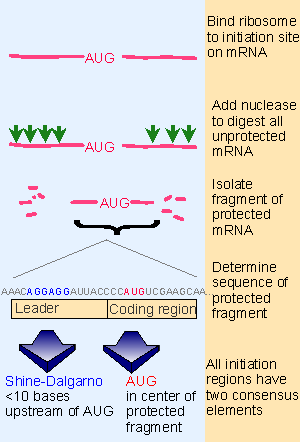5. Initiation involves base pairing between mRNA and rRNA
6.5 Initiation involves base pairing between mRNA and rRNA |
 |
Figure 6.15 Ribosome-binding sites on mRNA can be recovered from initiation complexes. |
An mRNA contains many AUG triplets: how is the initiation codon recognized as providing the starting point for translation? The sites on mRNA where protein synthesis is initiated can be identified by binding the ribosome to mRNA under conditions that block elongation. Then the ribosome remains at the initiation site. When ribonuclease is added to the blocked initiation complex, all the regions of mRNA outside the ribosome are degraded, but those actually bound to it are protected, as illustrated in Figure 6.15. The protected fragments can be recovered and characterized.
The initiation sequences protected by bacterial ribosomes are ~30 bases long. The ribosome-binding sites of different bacterial mRNAs display two common features:
- The AUG (or less often, GUG or UUG) initiation codon is always included within the protected sequence.
- Within 10 bases upstream of the AUG is a sequence that corresponds to part or all of the hexamer
5′ ... A G G A G G ... 3′
This polypurine stretch is known as the Shine-Dalgarno sequence. It is complementary to a highly conserved sequence close to the 3′ end of 16S rRNA. Written in reverse direction, the rRNA sequence is the hexamer:
3′ ... U C C U C C ... 5′
Does the Shine-Dalgarno sequence pair with its complement in rRNA during mRNA-ribosome binding? Mutations of both partners in this reaction demonstrate its importance in initiation. Point mutations in the Shine-Dalgarno sequence can prevent an mRNA from being translated. And the introduction of mutations into the complementary sequence in rRNA is deleterious to the cell and changes the pattern of protein synthesis. The decisive confirmation of the base pairing reaction is that a mutation in the Shine-Dalgarno sequence of an mRNA can be suppressed by a mutation in the rRNA that restores base pairing.
The sequence at the 3′ end of rRNA is conserved between prokaryotes and eukaryotes except that in all eukaryotes there is a deletion of the five-base sequence CCUCC that is the principal complement to the Shine-Dalgarno sequence. There does not appear to be base pairing between eukaryotic mRNA and 18S rRNA. This is a significant difference in the mechanism of initiation.
In bacteria, a 30S subunit binds directly to a ribosome-binding site. As a result, the initiation complex forms at a sequence surrounding the AUG initiation codon. When the mRNA is polycistronic, each coding region starts with a ribosome-binding site.
The nature of bacterial gene expression means that translation of a bacterial mRNA proceeds sequentially through its cistrons. At the time when ribosomes attach to the first coding region, the subsequent coding regions have not yet even been transcribed. By the time the second ribosome site is available, translation is well under way through the first cistron.,
 |
Figure 6.16 Initiation occurs independently at each cistron in a polycistronic mRNA. When the intercistronic region is longer than the span of the ribosome, dissociation at the termination site is followed by independent reinitiation at the next cistron. Animated figure |
What happens between the coding regions depends on the individual mRNA. Probably in most cases the ribosomes bind independently at the beginning of each cistron. The most common series of events is illustrated in Figure 6.16. When synthesis of the first protein terminates, the ribosomes leave the mRNA and dissociate into subunits. Then a new ribosome must assemble at the next coding region, and set out to translate the next cistron.
In some bacterial mRNAs, translation between adjacent cistrons is directly linked, because ribosomes gain access to the initiation codon of the second cistron as they complete translation of the first cistron. This effect requires the space between the two coding regions to be small. It may depend on the high local density of ribosomes; or the juxtaposition of termination and initiation sites could allow some of the usual intercistronic events to be bypassed. A ribosome physically spans ~30 bases of mRNA, so that it may simultaneously contact a termination codon and the next initiation site if they are separated by only a few bases.